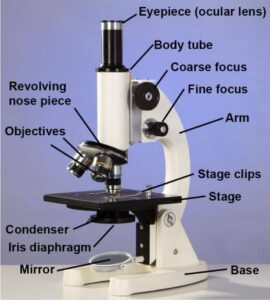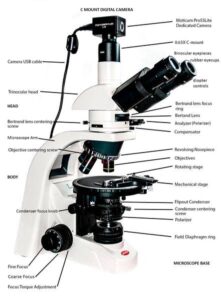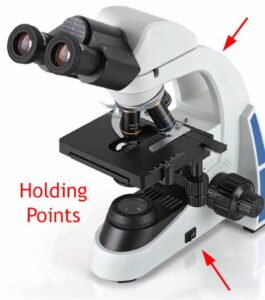Back to: MICROBIOLOGY 100 LEVEL
Welcome to class!
Hello my science superstar! I’m so happy to see your bright face back in class today. You’re doing amazing work, and I’m really proud of how far you’ve come. Today, we’re going to talk about something very important for every microbiologist or biology student—the microscope. This tool helps us see things that are invisible to the naked eye. But just like your favourite gadget, you have to know how to use it properly and take good care of it so it works well. Let’s learn how!
Use And Care Of The Microscope
What is a Microscope Used For?
A microscope is a tool used to magnify tiny things, like cells, bacteria, fungi, or even small algae, so we can see them clearly. In microbiology, it’s like your magic eyes—it shows you the hidden world of microorganisms.

Think of it this way: without a microscope, trying to study microbes is like trying to read without your glasses—everything is blurry. But with it, the invisible becomes visible.
How to Use a Microscope Properly
Let’s go through a few simple steps to use a light microscope the right way:
Set up your workstation: Place the microscope on a clean, flat table away from the edge.
Plug it in (if it’s electric) and switch on the light source or adjust the mirror to reflect sunlight.
Prepare your slide: Put the specimen on a clean slide, cover it with a cover slip.

Place the slide on the stage and secure it with stage clips.
Start with the lowest magnification lens (usually the shortest one).
Use the coarse adjustment knob to bring the specimen into focus.
Once you see the image, switch to a higher magnification and use the fine adjustment knob to sharpen it.
Adjust the diaphragm to control the amount of light.
When done, lower the stage, remove the slide, and turn off the light.
How to Care for Your Microscope
A microscope is delicate and needs gentle handling. Follow these tips to keep it in good condition:
Always carry it with two hands—one on the arm and one under the base.
Never touch the lenses with your fingers—use lens paper to clean them.
Keep it covered when not in use to protect it from dust.
Clean the stage and lenses after every use.
Store it in a dry, cool place, especially during the rainy season to avoid rust.

If the microscope has a mirror, never direct sunlight into it—it can damage your eyes.
Taking good care of your microscope means it will last longer and always give you a clear view of your tiny specimens.
Summary
- Microscopes help magnify tiny organisms like bacteria and cells.
- Use the lowest lens first, focus with the coarse knob, then switch to higher magnification.
- Always clean, cover, and store your microscope properly after use.
- Handle it gently and never touch the lenses with your fingers.
Evaluation
- What is a microscope used for in microbiology?
- Which knob should you use first when focusing?
- Mention two ways to take care of a microscope.
- Why should you never touch the lens with your fingers?
Now you know how to use and take care of one of the most important tools in science. With this skill, you’re already thinking like a real microbiologist! Keep up the amazing work—Afrilearn is here cheering you on every step of the way. See you in the next lesson, champion!
